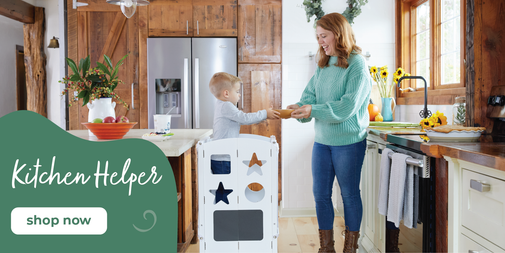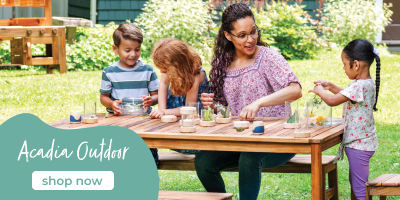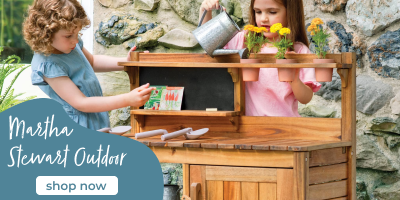3 activités scientifiques faciles à faire avec vos enfants
Les enfants sont naturellement curieux du monde qui les entoure. Les activités scientifiques offrent aux enfants une occasion unique d'utiliser cette curiosité naturelle et leur désir d'explorer tout en s'engageant dans des activités d'apprentissage pratiques. En général, faire des activités scientifiques à la maison avec votre enfant lui donne l'occasion de :
- Entraînez-vous à suivre les instructions
- Apprenez à faire des prédictions et à discuter des observations
- En savoir plus sur la cause et l'effet
- Découvrir les changements

Achetez une table et un auvent pour système sensoriel
Les activités scientifiques sont un excellent moyen pour les enfants d'explorer et de découvrir comment fonctionne le monde. Vous trouverez ci-dessous trois activités scientifiques faciles à essayer avec vos enfants pour encourager la pensée scientifique !
1. Couler ou flotter
Couler ou flotter est une activité scientifique facile à essayer à la maison ! Aidez votre enfant à trouver des jouets qui peuvent aller dans l'eau ou à sortir et à ramasser des objets de la nature. Parmi les idées, citons les glands, les bâtons, les pommes de pin, les feuilles ou une pomme tombée. Les objets couleront ou flotteront en fonction de leur densité par rapport à l'eau. Les objets moins denses que l'eau flotteront, tandis que les objets plus denses que l'eau couleront.
Comment commencer :
1. Remplissez un bac profond d’eau.
2. Choisissez un objet et demandez à votre enfant de prédire s’il va couler ou flotter.
3. Placez l’objet dans l’eau pour déterminer si le résultat correspond à votre prédiction.
4. Répétez avec plus d’objets.
5. Discutez de vos observations.
Prolongez l'expérience :
1. Créez une liste de vos articles. Vous pouvez écrire la liste sur papier ou sur un tableau noir. À côté de la liste des articles, créez des colonnes avec les titres « couler » et « flotter ». Après avoir testé chaque article, placez un « x » dans la colonne correspondante pour indiquer si l’article a coulé ou flotté.
2. Réactions pétillantes colorées avec du bicarbonate de soude et du vinaigre
Lorsque vous mélangez du bicarbonate de soude et du vinaigre, des réactions se produisent et produisent du gaz carbonique. Ce gaz produit le pétillement que vous voyez lorsque vous faites cette activité scientifique classique à la maison. La réaction pétillante fascine toujours les enfants, et ils adorent ajouter du vinaigre au bicarbonate de soude pour observer les bulles. Pour des réactions pétillantes colorées, vous pouvez ajouter du colorant alimentaire au vinaigre.
Comment commencer :
1. Placez une couche de bicarbonate de soude au fond d’un bac.
2. Remplissez des flacons compressibles* de vinaigre blanc (ou de vinaigre blanc dilué avec de l’eau 1:1).
3. Ajoutez 2 à 3 gouttes de colorant alimentaire au vinaigre et mélangez.
4. Laissez l’enfant explorer les réactions pétillantes en giclant le vinaigre coloré sur le bicarbonate de soude.
*Vous pouvez également placer le vinaigre blanc dans un moule à muffins et demander à l’enfant d’utiliser un compte-gouttes pour ajouter le vinaigre au bicarbonate de soude !
Prolongez l'expérience :
1. Essayez de mélanger deux couleurs primaires. Que se passe-t-il si vous ajoutez du vinaigre bleu au bicarbonate de soude, puis du vinaigre jaune ? Quelle couleur est créée ?
2. Essayez d'ajouter du liquide vaisselle au vinaigre. Que se passe-t-il lorsque vous mélangez le vinaigre avec le bicarbonate de soude ? Remarquez-vous des différences dans la réaction pétillante ? (Avec du liquide vaisselle ajouté, vous devriez remarquer que la réaction est pétillante et mousseuse !)
Chaque fois qu’un enfant utilise du bicarbonate de soude ou du vinaigre, je recommande de lui faire porter des lunettes de sécurité ou des lunettes de soleil.
3. Oobleck
L'oobleck est un fluide non newtonien possédant à la fois les propriétés des liquides et des solides. Si vous passez lentement vos doigts dans l'oobleck, il se comporte comme un liquide. Mais si vous appuyez dessus avec plus de force, il se comporte comme un solide !
Comment commencer :
1. Pour créer un oobleck, mélangez 2 parts de fécule de maïs et 1 part d’eau.
2. Facultatif : ajoutez du colorant alimentaire à l’eau avant de mélanger.
3. Placez l'oobleck dans une poubelle et laissez l'enfant l'explorer avec ses mains.
Prolongez l'expérience :
1. Essayez d'ajouter des jouets dans l'oobleck. Nous adorons ajouter des petits pavés ou des petites briques à l'oobleck. Les enfants peuvent essayer de construire des tours ou nos structures en utilisant les jouets et l'oobleck.
2. Essayez d'ajouter de la force à l'oobleck. Que se passe-t-il si vous appuyez rapidement votre main sur l'oobleck ? Que se passe-t-il si vous déplacez lentement votre main à travers l'oobleck ? Essayez de prendre une poignée d'oobleck et de la rouler en boule avec vos deux mains. Qu'arrive-t-il à la boule que vous formez si vous maintenez votre main immobile ?
Faire des activités scientifiques à la maison est un excellent moyen pour votre enfant de mettre en pratique des compétences essentielles, notamment la motricité fine, les compétences linguistiques, la pensée critique et les compétences sociales. Les activités scientifiques offrent de nombreuses possibilités d'apprentissage pratique pour les enfants et, surtout, elles sont amusantes pour les enfants !




















